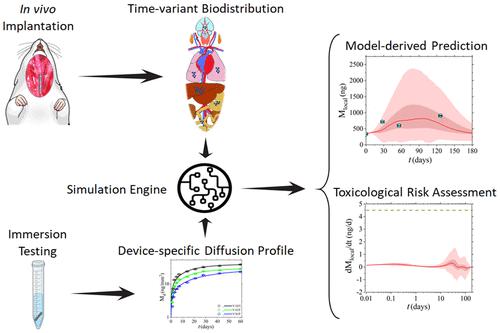当前位置:
X-MOL 学术
›
ACS Biomater. Sci. Eng.
›
论文详情
Our official English website, www.x-mol.net, welcomes your feedback! (Note: you will need to create a separate account there.)
A Predictive Toxicokinetic Model for Nickel Leaching from Vascular Stents
ACS Biomaterials Science & Engineering ( IF 5.8 ) Pub Date : 2024-03-25 , DOI: 10.1021/acsbiomaterials.3c01436 Matheos Giakoumi 1 , Pavlos S. Stephanou 2 , Despoina Kokkinidou 1 , Chara Papastefanou 3 , Andreas Anayiotos 1 , Konstantinos Kapnisis 1
ACS Biomaterials Science & Engineering ( IF 5.8 ) Pub Date : 2024-03-25 , DOI: 10.1021/acsbiomaterials.3c01436 Matheos Giakoumi 1 , Pavlos S. Stephanou 2 , Despoina Kokkinidou 1 , Chara Papastefanou 3 , Andreas Anayiotos 1 , Konstantinos Kapnisis 1
Affiliation

|
In vitro testing methods offer valuable insights into the corrosion vulnerability of metal implants and enable prompt comparison between devices. However, they fall short in predicting the extent of leaching and the biodistribution of implant byproducts under in vivo conditions. Physiologically based toxicokinetic (PBTK) models are capable of quantitatively establishing such correlations and therefore provide a powerful tool in advancing nonclinical methods to test medical implants and assess patient exposure to implant debris. In this study, we present a multicompartment PBTK model and a simulation engine for toxicological risk assessment of vascular stents. The mathematical model consists of a detailed set of constitutive equations that describe the transfer of nickel ions from the device to peri-implant tissue and circulation and the nickel mass exchange between blood and the various tissues/organs and excreta. Model parameterization was performed using (1) in-house-produced data from immersion testing to compute the device-specific diffusion parameters and (2) full-scale animal in situ implantation studies to extract the mammalian-specific biokinetic functions that characterize the time-dependent biodistribution of the released ions. The PBTK model was put to the test using a simulation engine to estimate the concentration–time profiles, along with confidence intervals through probabilistic Monte Carlo, of nickel ions leaching from the implanted devices and determine if permissible exposure limits are exceeded. The model-derived output demonstrated prognostic conformity with reported experimental data, indicating that it may provide the basis for the broader use of modeling and simulation tools to guide the optimal design of implantable devices in compliance with exposure limits and other regulatory requirements.
中文翻译:

血管支架镍浸出的预测毒代动力学模型
体外测试方法为了解金属植入物的腐蚀脆弱性提供了宝贵的见解,并能够在设备之间进行快速比较。然而,它们在预测体内条件下植入物副产物的浸出程度和生物分布方面存在不足。基于生理学的毒代动力学 (PBTK) 模型能够定量地建立此类相关性,因此为推进非临床方法测试医疗植入物和评估患者接触植入物碎片的情况提供了强大的工具。在这项研究中,我们提出了一个多室 PBTK 模型和一个用于血管支架毒理学风险评估的模拟引擎。该数学模型由一组详细的本构方程组成,这些方程描述了镍离子从装置到种植体周围组织和循环的转移,以及血液与各种组织/器官和排泄物之间的镍质量交换。使用以下方法进行模型参数化:(1)来自浸入测试的内部产生的数据,以计算设备特定的扩散参数;以及(2)全尺寸动物原位植入研究,以提取表征时间的哺乳动物特定的生物动力学函数。释放离子的依赖性生物分布。使用模拟引擎对 PBTK 模型进行测试,以估计从植入设备中浸出的镍离子的浓度-时间曲线以及通过概率蒙特卡罗的置信区间,并确定是否超出允许的暴露限制。模型导出的输出证明了预后与报告的实验数据的一致性,表明它可以为更广泛地使用建模和仿真工具提供基础,以指导植入式设备的优化设计,使其符合暴露限制和其他监管要求。
更新日期:2024-03-25
中文翻译:

血管支架镍浸出的预测毒代动力学模型
体外测试方法为了解金属植入物的腐蚀脆弱性提供了宝贵的见解,并能够在设备之间进行快速比较。然而,它们在预测体内条件下植入物副产物的浸出程度和生物分布方面存在不足。基于生理学的毒代动力学 (PBTK) 模型能够定量地建立此类相关性,因此为推进非临床方法测试医疗植入物和评估患者接触植入物碎片的情况提供了强大的工具。在这项研究中,我们提出了一个多室 PBTK 模型和一个用于血管支架毒理学风险评估的模拟引擎。该数学模型由一组详细的本构方程组成,这些方程描述了镍离子从装置到种植体周围组织和循环的转移,以及血液与各种组织/器官和排泄物之间的镍质量交换。使用以下方法进行模型参数化:(1)来自浸入测试的内部产生的数据,以计算设备特定的扩散参数;以及(2)全尺寸动物原位植入研究,以提取表征时间的哺乳动物特定的生物动力学函数。释放离子的依赖性生物分布。使用模拟引擎对 PBTK 模型进行测试,以估计从植入设备中浸出的镍离子的浓度-时间曲线以及通过概率蒙特卡罗的置信区间,并确定是否超出允许的暴露限制。模型导出的输出证明了预后与报告的实验数据的一致性,表明它可以为更广泛地使用建模和仿真工具提供基础,以指导植入式设备的优化设计,使其符合暴露限制和其他监管要求。



























 京公网安备 11010802027423号
京公网安备 11010802027423号